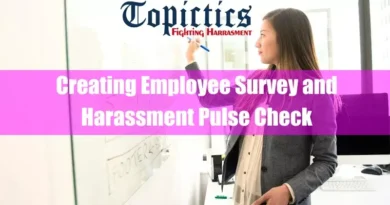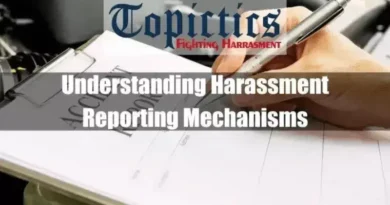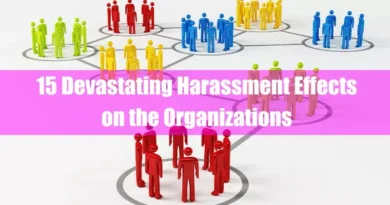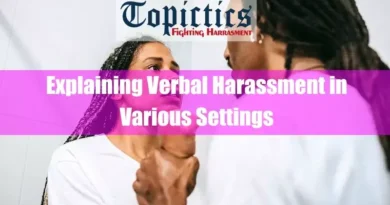I. Introduction
Our world thrives on respectful interactions, and feeling safe daily is paramount. Unfortunately, this sense of security can be shattered by physical harassment and discrimination. These interconnected issues can have devastating consequences, and understanding them is crucial for creating a more inclusive and respectful environment for everyone.
Physical harassment often becomes a tool for discrimination. When unwanted physical contact or threats target someone based on their protected characteristic, it becomes both physical harassment and discrimination. For example, a racist shove in a crowded hallway or unwelcome sexual advances toward a female employee are clear examples of this intersection.
Understanding these concepts is the first step toward creating a society free from harassment and discrimination.
II. Understanding Physical Harassment and Discrimination

A. Defining Physical Harassment
Physical harassment is unwelcome physical contact or behavior that makes someone feel unsafe, uncomfortable, or threatened. It can be a single, severe incident or a repeated pattern of undesirable actions. Here are some key aspects to consider:
- Unwanted Physical Contact: This includes touching, grabbing, or hugging, which is not consensual. Even seemingly casual gestures like putting an arm around someone’s shoulder can be considered harassment if it makes them feel uncomfortable.
- Threats and Intimidation: Verbal threats of violence, damage to property, or harm to one’s reputation constitute physical harassment. Additionally, aggressive body language, like standing too close or making menacing gestures, can also be a form of intimidation.
- Restriction of Movement: Blocking someone’s path, cornering them in a secluded area, or physically preventing them from leaving a situation can be physical harassment. This can be particularly frightening and isolating.
- Intimidation through Physical Presence: Deliberately standing too close in a threatening manner, towering over someone, or invading personal space can be intimidating and constitute harassment.
- Physical Attacks: This includes any act of violence, such as shoving, tripping, punching, kicking, or using weapons.
Examples of Physical Harassment in Different Settings:
The nature of physical harassment can vary depending on the context. Here are some common examples:
1. Workplace:
Unwanted touching, blocking someone’s path, cornering an employee in a secluded area, throwing objects, or physical assault. Slamming objects on a desk, throwing things, or other aggressive displays of power can intimidate and create a hostile work environment.
2. School:
Shoving, tripping, pinching, hair pulling, bullying tactics like locker slamming or physical attacks. Deliberately excluding someone from physical activities or games during gym class or recess can be a form of physical harassment, particularly if done repeatedly.
3. Public Places:
Following someone closely, groping or other forms of unwanted sexual contact on public transportation, deliberate bumping or brushing against someone in a crowded space. While not always intentional, being aggressively crowded in a public space, like on public transportation or in a line, can be a form of physical harassment, especially to intimidate or control someone’s movement. Bumping into someone with excessive force or repeatedly brushing against them in a crowded space can be harassment, especially if done in a way that feels intentional or threatening.
B. Defining Discrimination
Discrimination occurs when someone is mistreated based on a characteristic that sets them apart from a dominant group. These characteristics are legally protected, and treating someone differently because of them is not only unfair but often illegal.
- Protected Characteristics: These vary depending on the country, but some common ones include race, religion, ethnicity, national origin, gender, sexual orientation, age, disability, pregnancy, and marital status.
- How discrimination can Manifest: Discrimination can be subtle or overt. It can involve denying someone opportunities (e.g., promotions, scholarships), creating a hostile environment through insults or derogatory jokes, or segregation (e.g., separate restrooms for different races).
Also, read:
- 20 Quid Pro Quo Harassment Examples and How to Stop Them
- Understanding & Addressing Microinsults
- 15 Devastating Harassment Effects on the Organizations
III. The Impact of Physical Harassment and Discrimination

The effects of physical harassment and discrimination are far-reaching and can significantly impact a person’s life. These issues go beyond the immediate discomfort or fear; they can profoundly influence a person’s mental, physical, and social well-being.
A. Psychological Effects
The experience of being harassed or discriminated against can take a significant toll on a person’s mental health. Here are some common psychological effects:
- Anxiety and Fear: Constant vigilance, hyperarousal, and a pervasive sense of danger can become a daily reality for victims. This anxiety can manifest in panic attacks, difficulty concentrating, and a fear of leaving the house or going to work/school.
- Depression and Low Self-Esteem: Repeated harassment and discrimination can chip away at a person’s self-worth. Feelings of isolation, helplessness, and hopelessness can lead to depression, making it difficult to find joy in everyday life.
- Post-Traumatic Stress Disorder (PTSD): In severe cases, especially when physical harassment involves violence, victims may develop PTSD. This condition can manifest in flashbacks, nightmares, and severe emotional distress in response to triggers that remind them of the incident.
B. Physical Effects
The psychological strain of harassment and discrimination can often manifest in physical ways:
- Injuries: Physical assaults are the most obvious consequence, but even repeated unwanted physical contact can lead to minor injuries or chronic pain.
- Chronic Health Problems: The stress of harassment and discrimination can weaken the immune system and increase the risk of developing chronic health problems like high blood pressure, heart disease, and digestive issues.
- Difficulty Sleeping: The anxiety and fear associated with harassment can disrupt sleep patterns, leading to fatigue, difficulty concentrating, and a weakened immune system.
C. Social Effects
The social fabric of a person’s life can also be severely damaged by harassment and discrimination:
- Isolation and Withdrawal: Victims may withdraw from social activities, hobbies, and even close relationships to avoid further harassment or discrimination.
- Damaged Relationships: The stress and emotional turmoil can strain relationships with family, friends, and romantic partners.
- Difficulty Maintaining Employment or Education: Fear of encountering the harasser or a hostile work/school environment can make concentrating, attending classes, or performing job duties difficult. This can lead to absenteeism, poor performance, and ultimately, job loss or academic failure.
The negative impact of physical harassment and discrimination is undeniable.
Also, read:
- Explaining Intersectionality in Quid Pro Quo Cases
- Cultural Norms and Harassment: Understanding the Link
- LGBTQ+ Vulnerability: Addressing Sexual Harassment
IV. Recognizing Signs of Physical Harassment and Discrimination

Unfortunately, physical harassment and discrimination often occur under the radar. Being able to recognize the signs is crucial for intervening and supporting victims. Here’s what to watch out for:
A. Verbal and Non-Verbal Cues in the Harasser/Discriminator
The perpetrator’s behavior can be a red flag. Look for:
Verbal: Insults, threats, and derogatory remarks targeting someone’s protected characteristics (e.g., race, religion, disability) are clear signs. Jokes or comments that make someone feel uncomfortable also fall under this category.
Non-Verbal: Glares, invading personal space, intimidating gestures, or mimicking someone mockingly are all signs of potential aggression. Additionally, paying close attention to how someone interacts with others can reveal discriminatory patterns.
B. Behavioral Changes in the Victim
Sometimes, the most telling signs come from the victim’s behavior. Here’s what might raise concerns:
- Withdrawal from Social Activities: Once outgoing individuals suddenly avoid social events or hobbies, it could be a sign they’re being harassed or discriminated against.
- Changes in Appearance or Personal Hygiene: A lack of interest in personal care, changes in eating or sleeping habits, or neglecting appearance can be indicators of emotional distress.
- Decline in Academic or Work Performance: Previously engaged students suddenly failing classes or employees showing a drop in productivity could be experiencing harassment at school or work.
C. The Importance of Bystander Intervention
Bystanders play a crucial role in stopping harassment and discrimination. Witnessing such behavior and not intervening can embolden the harasser and further isolate the victim. Recognizing the signs allows bystanders to take action, even if it’s something seemingly small.
Also, read:
- Explaining Sexual Favors Considering Harassment
- Explaining DE&I Initiatives: An Ultimate Guide
- Explaining Collaborating with External Resources
V. Legal Protections Against Physical Harassment and Discrimination

The good news is that you don’t have to face physical harassment and discrimination alone. Several legal frameworks exist to protect individuals and hold perpetrators accountable.
A. International Laws and Conventions:
International human rights law sets the foundation for legal protections. For instance, the Universal Declaration of Human Rights guarantees everyone the right to equality and freedom from discrimination. Additionally, specific conventions like the Convention on the Elimination of All Forms of Discrimination Against Women (CEDAW) address discrimination based on gender.
B. U.S. Laws
In the United States, federal and state laws offer protection against physical harassment and discrimination. Here’s a breakdown:
1. Federal Anti-discrimination Legislation:
- Title VII of the Civil Rights Act of 1964 prohibits discrimination based on race, color, religion, sex (including pregnancy), and national origin.
- Title IX of the Education Amendments of 1972 prohibits discrimination based on sex (including sexual harassment) in any educational program or activity receiving federal financial assistance. This applies to public and private elementary schools, secondary schools, postsecondary institutions, and vocational education programs.
- The Americans with Disabilities Act (ADA) protects individuals with disabilities from discrimination in employment, public services, telecommunications, and transportation.
- The Age Discrimination in Employment Act (ADEA) protects individuals 40 years or older from discrimination based on age.
2. Laws Addressing Harassment in Specific Settings:
- Workplace Harassment Laws: The Equal Employment Opportunity Commission (EEOC) enforces federal laws prohibiting harassment based on a protected characteristic (race, religion, sex, etc.) This creates a hostile work environment. You can find more information on the EEOC website: https://www.eeoc.gov/.
- School Anti-Bullying Legislation: The U.S. Department of Education provides resources and guidance on preventing and responding to bullying in schools. You can find more information on their website: https://www.stopbullying.gov/.
It’s important to note that state and local laws may offer additional protections beyond federal laws. You can find relevant resources through your state government website or legal aid organizations.
C. Reporting Mechanisms
Knowing your rights is crucial, but it’s equally important to understand how to report incidents. Here are some common reporting mechanisms:
- Internal Reporting Procedures in Workplaces or Schools: Many institutions have established policies and procedures for reporting harassment and discrimination. These procedures typically involve reporting to a supervisor, human resources department, or a designated official within the school administration.
- Filing a Complaint with Law Enforcement or Regulatory Agencies: Depending on the severity of the incident, you may have the right to file a complaint with law enforcement or a regulatory agency. For example, physical assault may warrant a police report. At the same time, workplace discrimination might be addressed by a government agency responsible for enforcing anti-discrimination laws.
Understanding these legal protections empowers individuals to seek justice and hold perpetrators accountable.
Also, read:
- Explaining National Origin-Based Quid Pro Quo Harassment
- Creating Employee Survey for Harassment Assessment
- Explicit Quid Pro Quo Harassment: A Comprehensive Overview
VI. Strategies for Responding to Physical Harassment and Discrimination

Being targeted by physical harassment and discrimination can be overwhelming. Still, there are steps you can take to protect yourself and address the situation. Here’s what you can do:
A. Steps for Victims
- Documenting Incidents: Record each incident, including the date, time, location, details of what happened, and any witnesses present. This documentation can be crucial if you file a formal complaint.
- Reporting to Authorities: Depending on the severity of the incident, consider reporting it to the appropriate authorities. For physical assault, contact the police. For workplace harassment, report it to your supervisor or human resources department. If you’re a student experiencing bullying, report it to a school administrator.
- Seeking Support: The emotional toll of harassment and discrimination can be significant. Don’t hesitate to seek support from mental health professionals to help you cope with the stress and trauma. Additionally, connecting with support groups for victims of harassment or discrimination can provide valuable resources and a sense of community.
- Self-Care Strategies: Prioritize your well-being—practice stress management techniques like yoga, meditation, or deep breathing exercises. Maintaining healthy sleep patterns and a balanced diet supports your emotional and physical health.
B. Bystander Intervention Techniques
Bystanders have a critical role to play in stopping harassment and discrimination. Here are some ways you can intervene safely and effectively:
- Direct Intervention: If the situation allows, you can directly address the harasser. Speak up firmly but calmly, expressing your disapproval of their behavior.
- Social Disapproval: Sometimes, a simple signal of disapproval can be effective—express discomfort with the situation through body language or facial expressions. You can also casually join the conversation with the victim to subtly shift the dynamic.
- Seeking Help from Authorities on Behalf of the Victim: If direct or social interventions feel unsafe, discreetly seek help from a supervisor, security personnel, or a trusted adult. Reporting the incident on behalf of the victim can still be a powerful act of support.
Remember, safety comes first. Don’t put yourself in danger if directly intervening feels risky. However, you can empower the victim by taking action and communicating that harassment and discrimination are not tolerated.
Also, read:
- Introduction to Coercive Quid Pro Quo Harassment
- Quid Pro Quo Harassment in the Military: The Best Guide
- 16 Physical Effects of Quid Pro Quo Harassment.
VII. Creating a Culture of Respect and Inclusion

Eradicating physical harassment and discrimination requires a shift in our collective mindset, moving towards a culture of respect and inclusion. Here’s how both organizations and individuals can contribute:
A. The Role of Organizations (Workplaces, Schools, etc.)
Organizations have a responsibility to create safe and respectful environments for everyone. This proactive approach requires several vital strategies:
- Implementing Anti-Harassment Policies and Procedures: Clear policies outlining acceptable and unacceptable behavior and a well-defined complaint process are crucial. These policies should be readily available to all employees or students.
- Providing Training on Recognizing and Preventing Harassment: Training sessions can equip staff, faculty, and students with the necessary skills to identify harassment and discrimination, as well as how to intervene safely and effectively.
- Fostering a Culture of Open Communication and Reporting: Organizations must create an environment where individuals feel comfortable reporting incidents without fear of retaliation. This can involve establishing anonymous reporting mechanisms and promoting open communication with supervisors or designated officials.
Related articles:
- How to Create an Effective Anti-Harassment Policy Under Title IX.
- How to Provide Anti-harassment Training in Schools
B. Individual Responsibility
Individual actions also contribute significantly to a respectful environment:
- Respecting Personal Boundaries: Being mindful of personal space and respecting physical boundaries is essential. Avoid unwanted touching, jokes, or comments that make someone uncomfortable.
- Challenging Discriminatory Attitudes and Jokes: Don’t be a silent bystander. Challenge discriminatory jokes or comments, even if they seem harmless. Speak up and emphasize respect for all.
- Promoting Diversity and Inclusion: Actively celebrate diversity and encourage inclusivity. Recognize and appreciate the unique experiences and perspectives that everyone brings to the table.
By working together, individuals and organizations can create a society where everyone feels safe, respected, and valued.
Also, read:
VIII. Conclusion
Physical harassment and discrimination are interconnected issues with devastating consequences. Recognizing the signs, understanding legal protections, and taking action are crucial. Bystanders play a vital role in intervention while fostering a culture of respect and inclusion, which requires collaboration between individuals and organizations.
Important Note:
Self-harm wouldn’t be considered physical harassment. Harassment requires an external actor to target someone else. While self-harm involves physical injury, it’s directed at oneself and doesn’t involve the intent to bully or control another person, which is a critical element of physical harassment.
Also, read:
- Explaining Non-Sexual Quid Pro Quo Harassment.
- The 13 Legal Implications of Quid Pro Quo Harassment
- Quid Pro Quo History Examples: A Complex Dance of Mutual Exchange









